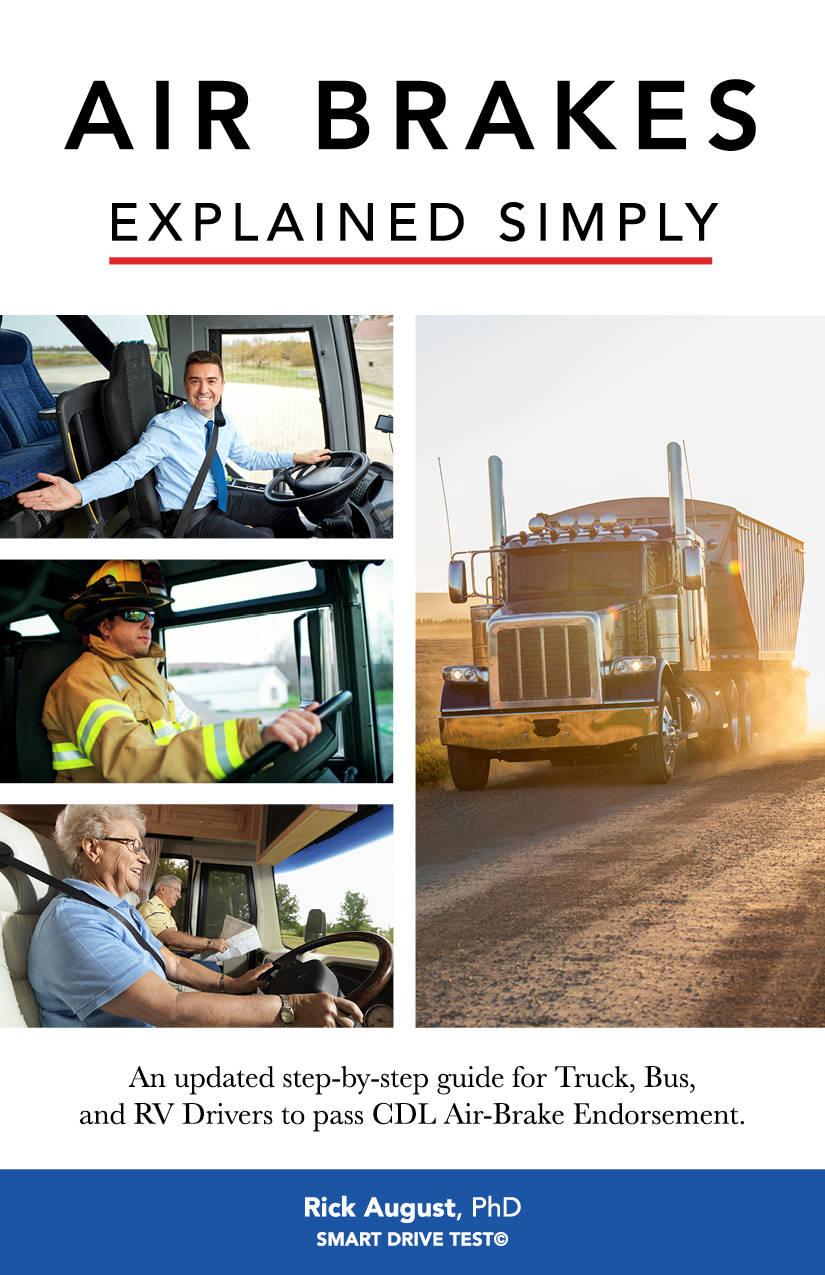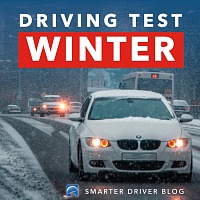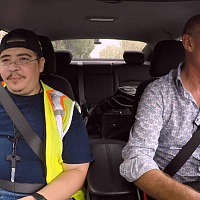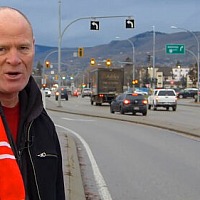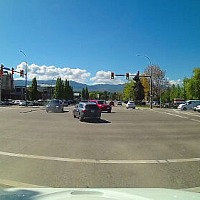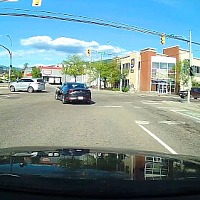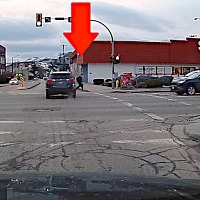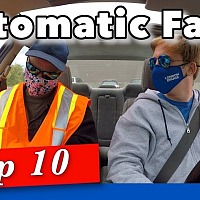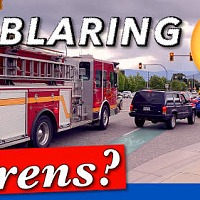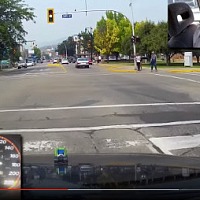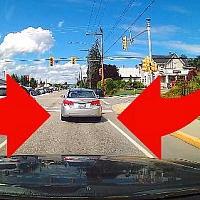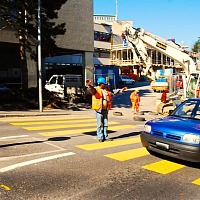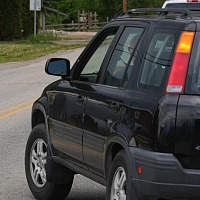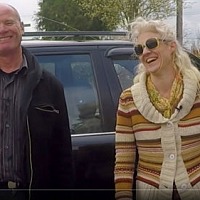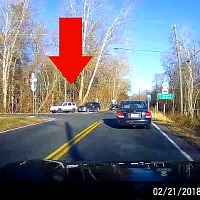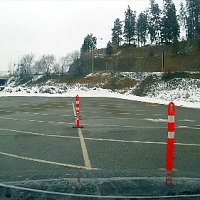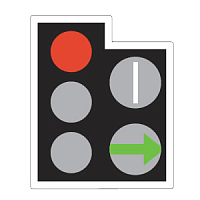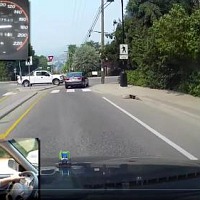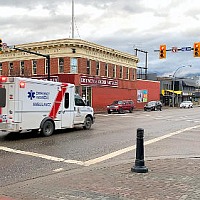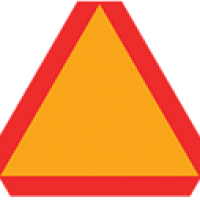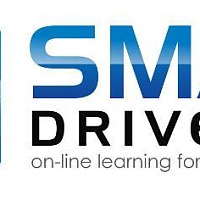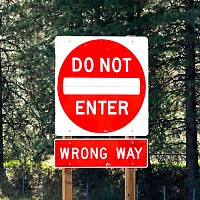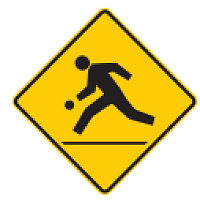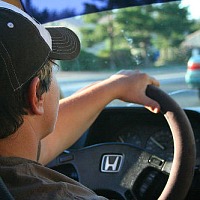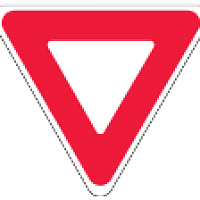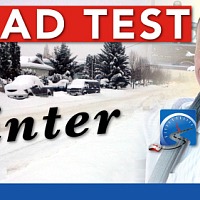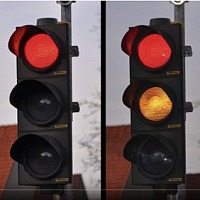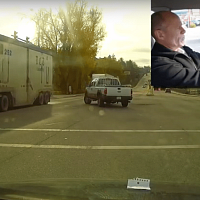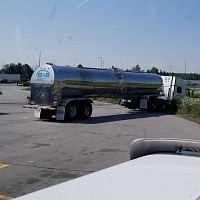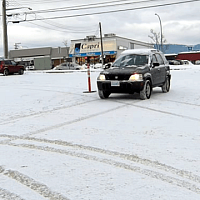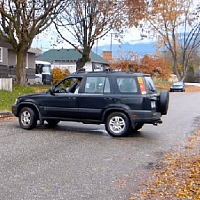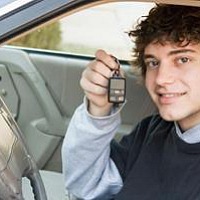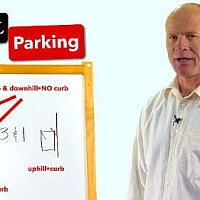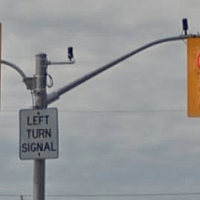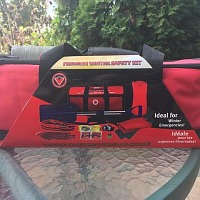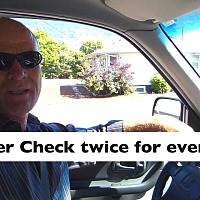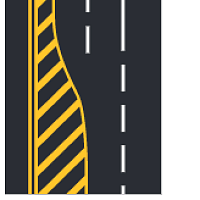Watch the video for right-of-way rules to pass your road test.
Learning to Drive & Determine Right-of-Way or Give Way
Closed Caption
Introduction
Hi there smart drivers.
Rick with Smart Drive Test talking to you today about right-of-way at different intersections for the purposes of a road test.
Now just before we get started here, be sure to hit that subscribe button...right about there.
That way you'll get access to all of the great information as I get it available to you for those of you working towards you license or starting your career as a truck or bus driver.
Now this video is going to give you an overview of right-of-way at different configured intersections.
Mostly in residential areas.
We're not going to do complex intersections on major highways and thoroughfares for the purposes of this video.
I'll do another video on complex intersections and right-of-way.
Everything that I talk about--stop signs, yields, and right of way from alleyways onto public highways-- all of the links are down in the description.
So have a look down there if you want more detail on a particular section.
As I said, this is just an overview of different kinds of intersections that you're going to encounter for the purposes of your road test.
As well, keep in mind what I always say to students, "you can be right, or you can be dead right."
Just because you have the right-of-way legally, you need to think about it defensively.
If you go, are you going to risk a crash with another road user, and are you doing something defensive, and are you keeping the examiner safe, are you keeping other people and other road users safe?
Get Your "How to Pass Your Driver's Test First Time"
• FEAR :: Learn the correct skills, abilities, and techniques that are required to pass your driver's test;
• SELF-CONFIDENCE :: Get the exact skills from a licensed driving instructor that will guarantee your success;
• CONFUSION :: Cut through the conflicting and incorrect information;
• QUALIFIED :: Smart Drive Test has helped 1000s to pass their drivers' test...and we can help you!
So sometimes you have to yield even though you have the right-of-way.
So keep that in mind when you're driving.
And the other thing I'll say for the purposes of your road test.
If you're the least bit in doubt on your road test, STOP, simply STOP and wait for the other road users to move or carry on with their day and then proceed.
If you're the least bit in doubt, do not plow forward because oftentimes that results in an automatic fail on a road test.
Now one other thing that I'll mention to you is make sure that you practice in and around the licensing center where you're going to be taking your test.
Urban Planning
And think a little bit about urban planning.
Because here in Vernon we have two main north-south routes: 27th Ave. and Highway 97.
Those run north-south through the city and those are the major highways.
And you have to cross those if you're going east-west.
As well, Vernon is in the Okanagan Valley.
So if you see a mountain on your right and your left, you know you're heading north or south because they're on the east and west of the city.
And different cities in the world--some cities grew up with the motor-car.
Los Angeles, for example, grew up the motor car.
Old Cities
So it's streets are designed for motor cars.
If you get to London, England or you get to Mumbai in India, these old cities are not designed for cars.
 Sydney, Australia - if you get down on "The Rocks" underneath the Harbour Bridge there, its following the coastline - it's not on a grid.
Sydney, Australia - if you get down on "The Rocks" underneath the Harbour Bridge there, its following the coastline - it's not on a grid.
So know a little bit about the geography and how the city follows that geography and how the roads are planned, which roads are your main thoroughfares, which roads are going to stop every block because there's a STOP sign as the minor streets intersect with the major streets.
Because that's going to determine your right-of-way as well.
So think a little bit about how the city is laid out.
And I did watch one of the road tests in California there and it was a fairly easy road test - big wide streets, not many controls because the the urban planning was obviously done around the motor car.
You get into some of these older cities, it's not going to be the same.
It's going to be a little tougher for those of you taking a driver's test, and about right-of-way.
So what we're going to do today is we're going to go to different intersections, we're going to give you an overview of right-of-way and give you a little bit more information.
And as I said, the full details for each one of these intersections and right-of-way is down in the description box.
So look down there.
Stick around, we'll be right back with that information.
[INTRO & MUSIC]
Prologue
Hi there smart drivers.
Rick with Smart Drive Test talking to you today about right-of-way.
This video is giving you an overview of right-of-way in residential areas.
Now just before we start here, this was a request by ZijZ.
That's his user name and his YouTube channel, so be sure to check that out.
And he requested that I give an overview of right-of-way.
And this is residential areas; it's not complex intersections.
It is just residential areas - so controlled and uncontrolled intersections.
And for the most part you're not going to find uncontrolled intersections.
You can be RIGHT, or you can be DEAD right!
In residential areas, if you're turning off a major thoroughfare onto a minor roadway, then yes it's going to be uncontrolled.
But you still have to give the right-of-way to other road users that you might conflict with.
So for example, if there's pedestrians or bicycles and you're making a right-hand turn and they're coming up, you're going to have to shoulder check and ensure that they're not crossing the roadway because if they are, you have to give the right-of-way to them.
Most of this is at controlled intersection - so stop sign, yield sign, dead-end streets and streets that with "Do Not Enter."
So you either have to turn right or left at the intersection.
Also we're going to talk about alleyways and we're going to talk about what to do if you're at a stop sign facing another stop sign or are facing a private road and how you deal with that and give right-of-way to other road users for the purposes of the road test.
Dead End Streets
If you come down a road like this, the right-of-way, you have to give right away to other road users - any road users that are on a bicycle or pedestrians that are here.
Because obviously this sign up here behind me means a dead end.
And you're going to have to do a U-turn and go back the other way.

Because this is a sign that indicates that the road is the dead-end.
Now this is a quiet residential area and there aren't too many people in the area.
There is a footpath that comes up over the hill here, but as I said it's unlikely there's going to be anybody else around.
But do your proper scanning patterns.
You may have to do a three-point turn to get around on this road.
You would have to do a three-point turn in some instances on a cul-de-sac and those types of things.
On a cul-de-sac, they're not going to have this sign but on a cul-de-sac you're going to have to do a U-turn.
So simply give the right-of-way to other road users, pedestrians anybody pulling out of driveways and on scooters and bicycles and those types of things.
T-Intersection with "Do Not Enter"
This sign here behind me indicates that you either have to turn right or left at the intersection.
There's also a yield sign at this intersection, so you have to give the right-of-way.
You have to yield to all other road users in the intersection: vehicles, pedestrians, bicycles and people on scooters.
So before you can proceed through the intersection you have to give the right-of-way to all other road users.
You may have to stop, you may not.
So as you're proceeding towards the intersection and see the signs which are at this intersection, you can see in the image here there's a yield sign, there's a "Do Not Enter" sign and there's a sign indicating that the road comes to an end.
And you either have to turn left or right at the intersection to proceed.
So as you're coming up, be prepared to stop.
You don't necessarily have to stop, but go slowly, proceed around the intersection--whether you're going left or right--and give the right-of-way to all other road users in the intersection.
Alleyways
Behind me here is an alleyway.
There aren't any traffic controls at the alleyway, so you have to give the right-of-way to other road users: cars, people on scooters and bicycles, and children - those types of things.
Because we are in a residential area, so you don't have to stop, but you do have to slow down to a point where you can scan the intersection thoroughly and ensure that there aren't any other road users that you have to yield to or give the right-of-way to.
And for the purposes of a driver's test it's unlikely that an examiner is going to take you down an alleyway.
And just as a side note, on these alleyways, most of the driving manuals say that you need to proceed at a speed not faster than 20 kilometers an hour or 12 miles an hour in these alleyways.
Probably in most of the United States, it's going to be 10 miles per hour.
If you are thinking that there is a possibility you could be in an alleyway for the purposes of your road test, just make sure you look that up in your manual before going down for your road test.
Uncontrolled Intersection
This intersection behind me is an uncontrolled intersection.
There aren't any signs behind me to control how you act at the intersection.
So whether you're going left, you're going to go straight through--because there's a bit of a jog here at this intersection--you simply need to give the right-of-way to other road users.
And you may have to cover the brake because you can see there's construction work being done behind me here.
And yes, we are in the summertime and if you're taking a driving test now you're probably going to encounter road construction.
And you need to go slowly around these temporary work areas where construction workers are working and give the right-of-way to them.
So proceed slowly - you may have to cover the brake and I'll put a video up in the corner over here on this side for you on covering the brake and being prepared to stop in the event that one of these construction workers accidentally steps out in front of you or there's another road user.
Because this is a residential area and there could be cyclists and children and pedestrians and people with mobility challenges on scooters and those types of things.
So you need to be prepared to give the right-of-way or yield to other road users, even though it is an uncontrolled intersection.
Construction Zones
Construction zones.
Now that we're in the summertime and if you're taking a road test in the summertime you're going to have construction zones.
And you have to obey the signs--the temporary work signs around construction zones.
And you can see the flagger here in the background - you have to obey the directions of the flaggers and other traffic control people.
If you are in an emergency situation and you have a police officer directing traffic at an intersection, do not obey the traffic lights, rather obey the instructions of the traffic control person - whether that's a flagger or whether that's the police officer or what not.
Now construction zones...I was just talking to the two flaggers here behind me and unfortunately we had a flagger that was hit in a construction zone in Burnaby yesterday and she's alright, fortunately.
But know that when you're in construction zones you've got to take a deep breath, know that it's construction season and take your time, and give the right-of-way to other road users.
If somebody gets aggravated or start to exhibit signs of road rage, just you know, let them go and have their crash somewhere else.
As I said, let's just take a breath, take your time, give the right-of-way to other road users, and help other vehicles and traffic move through the construction zone and you'll get through the construction zone.
And as well, the flaggers and directional people that are there to help you out and facilitate the flow of traffic through these construction areas.
Because what they're doing is they're making our roads better so they're nicer to drive on.
And if you do not obey the directions of the flagger during your road test or do not obey the signs, unfortunately, most of the time that's going to be an automatic fail.
So make sure you take your time, give the right-of-way, and yield to other traffic and road users in around the construction zones.
Especially keep an eye out for construction workers and make sure that you obey the directions of the flaggers.
And you know, give them a little wave, because it doesn't take any time out of your day to be nice.
Roundabouts
I'll quickly talk about roundabouts here.
These are beginning to make an appearance on the driving landscape in North America.
And I'm sure those in the UK, Europe, Australia and other places that have prolific roundabouts...
they're having a bit of a chuckle at our expense of new and veteran drivers having challenges learning how to use roundabouts.
When I moved to Australia in the early-2000s--and they have tons and tons of roundabouts--there was a bit of a learning transition.
You have to scan the roundabouts back far, and you have to predict what the traffic in the roundabout is doing, and you have to be prepared to both go and stop at the same time.
Because as you can see on the sign here, it is a yield sign or give way to other traffic in the roundabout
Now if you're driving on the right, you go through the roundabouts in a counterclockwise direction and you give the right-of-way to vehicles approaching from the left.
If you're on the left side of the road, you're going to go through the roundabouts in a clockwise direction and you give way to traffic on that's approaching from the right.
The other thing a lot of people are confused about is signalling in a roundabout.
Think of it like a conventional intersection.
If you're going left; signal left; if you're going to go right, signal right as you're approaching the roundabout.
Now lots of the legislation in and around the world says "if practicable"--which means "IF" you can signal your intention to leave the roundabout.
So for those of us are travelling on the right, if you're going straight through, put the right signal on to indicate that you're leaving the roundabout.
And if you're on the left, put your left signal on to indicate that you're going to exit the roundabout.
That just indicates to other traffic that you are in fact leaving the roundabout.
So that's a bit of giving right-of-way and yielding to other traffic in a roundabout.
And like I said, I'll put a card up here for you in the corner on roundabouts.
Have a look at that if you want more information about roundabouts.
T-Intersection - Controlled
This intersection behind me is a T-intersection.
But other than the stop sign there aren't any traffic controls at this intersection.
There isn't a sign telling you that it's a T-intersection.
So this is why it's important to go and practice in the area in and around the licensing center where you will be taking your road tests so that you can get familiar with these intersections and know that it's just a stop sign.
As well, there aren't any stop lines here on this roadway or crosswalk lines and there isn't a sidewalk or a footpath.
So you have to stop where the two roads meet and then give the right-of-way to other traffic and other road users and then proceed after you come to a complete stop.
And I'll put a video up in the corner here on stopping positions for stop signs.
As well, I'll put a video up for coming to a complete stop and how to do that for the purposes of your road test.
So have a look at those videos as well, after you have a look at this overview on giving the right-of-way and yielding to other traffic.
So that's how you deal with this intersection that has a stop sign but no crosswalk line or stop line.
You stop where the two roads meet, come to a complete stop, give the right-of-way to all other road users.
After you come to a complete stop and then proceed.
And make sure you signal because you're going to have to go either right or left.
And the examiner, they're good about giving you plenty of notice about whether you have to turn right or left.
This intersection behind me here is a little bit more complicated than most of the intersections because there's a stop sign on this side of the intersection.
Private Roads
They Keep to Themselves
On the other side of the intersection is a private road.
The private road doesn't have any controls.
As well, the east-west thoroughfare is the through road that is one of the main through roads through this suburb.
So as you come up here you have to come to a complete stop before the stop line on the roadway.
And you have to yield and give the right-of-way to all other road users.
And if there's a vehicle across the way there and they're turning left or right--it's unlikely they're going to go straight through--but you have to give the right-of-way to them.
They have the right-of-way over you because there aren't any controls at that intersection over there.
So you have to wait for the intersection to clear completely before you either turn left or right, because it's unlikely that you're going to go straight through.
You're either going to turn left or right here.
You're not going to go on to that private roadway for the purposes of a driving test.
So know that - stop completely before the stop line, give the right-of-way to all of the road users in the intersection.
And the through road is busy, so you're going to have to take your time.
Come to a complete stop at the stop line and you probably won't be able to see at the intersection, so after you come to a complete stop, creep forward until you can see, give the right-of-way to all other road users.
There isn't a footpath or a sidewalk on this side of the road; there is on the other side there.
So most of the pedestrians are going to be on the other side of the road, but just keep a lookout for that and scan well before you proceed out in the intersection, and give the right-of-way to all other road users, and give the right-of-way to the traffic on the other side of the road because that's a public roadway and there aren't any controls on that road.
So give the right-of-way to all other road users-- scooters, bicycles, riders, vehicles.
And then proceed once the way is clear and you've given the right-of-way to all other road users.
Conventional Intersection
This intersection behind me is a conventional intersection.
The east-west road which runs this way is the main thoroughfare.
And there aren't any traffic controls on that roadway.
But the two roadways that intersect with it both have STOP signs.
And this intersection here on this side where I'm standing, you can see that there's a crosswalk line and there's a stop line.
So you have to stop before the STOP line and if you can't see the intersection clearly after you come to a complete stop before the stop line, then creep forward until you can see, give the right-of-way to all of the road users - pedestrians, bicycles, and riders, and people on scooters.
Because there is a bicycle lane that runs along the main thoroughfare there, so watch out for cyclists as well.
And as well, this is on a bit of a downhill so there are cyclists that are going to be screaming down the hill - probably at 40 or 50 kilometres an hour or 20 or 30 miles an hour if you're in the United States.
So know that you need to give the right-of-way to all of the road users.
And if there's a vehicle on the other side of the intersection that's turning in the same direction that you're turning--it depends on who arrives first-- so if you're proceeding straight you've got the right-of-way if the other vehicle is turning and you're proceeding straight.
You have the right-of-way if you're turning and the other vehicle is proceeding straight, then they have--that vehicle--has the right-of-way.
So know that in terms of right-of-way and yielding to other traffic.
But for the most part, when you come up to these intersections at the STOP sign, stop at the correct position completely.
And then if you can't see the intersection or get a clear view of the cross traffic, then you're going to creep forward, treat it as a yield, give the right-of-way to all of the road users, and then proceed.
Practice In & Around the Area Where You're Taking Your Test
And in North American cities, this is going to be the most common at these conventional crossroad intersections that you're going to have a STOP sign.
And you're going to have a main thoroughfare as I talked about in the introduction with urban planning and the layout of different cities.
And again, it's important that you practice in and around the area where you're going to be taking your test.
Just simply go to the map, and pick 10 to 15 minutes of drive time out on a radius from that driving center.
And that way you can practice in and around that area over the course of practicing and preparing for your road test.
4-Way Stop Signed Intersections
The intersection behind me is a four-way STOP.
Four-way stops can be a bit complicated for new drivers.
The first person to arrive or the vehicle on your right if you arrive and another vehicle arrives approximate at the same time is to let the vehicle on your right go.
And know that you're going to take turns.
So your line of traffic is going to go and then the cross traffic is going to go.
Now if two vehicles arrive at the same time, the vehicle across from you and you, the straight through vehicles have the right-of-way over the turning vehicles.
But once that vehicle proceeds straight, and if you're going to turn, it's your turn immediately after that straight-thru vehicle.
And I'll leave a down in the description box...
I'll leave a link to the full video on 4-way stops that will give more information about 4-way stops and the right-of-way and whose turn it is at the 4-way stop.
Because as I said, to the uninitiated they can be a bit complicated.
And if you're not sure, just go out to one of the local 4-way stops, sit at the corner for a few minutes and watch how the traffic moves through the intersection.
That'll give you a better understanding of how to move through a 4-way stop.
Because as well, when they're busy, if you go, the traffic oftentimes--the cross traffic-- is going to go if both of you are proceeding straight through.
So as well again, know that you have to come to a complete stop before the stop line, give way to other road users:
- bicycles,
- pedestrians
- and people on scooters and those types of things.
So it's a conventional stop sign.
All the rules apply: stop at the right position, and first person to arrive.
Take your turn or if you're unsure let the vehicle on the right go.
Yield signs - you have to give the right-of-way to other pedestrians, road users, cyclists, and those types of things.
This one is near a high school.
The high school is just over here to my right.
So in the morning when school lets in and the afternoon when school lets out this intersection is going to be fairly busy with pedestrians here at the crosswalk.
And you can see the crosswalk on the roadway there.
So you're going to have to give the right-of-way to pedestrians, cyclists and people on scooters when you're driving on these slip lanes.
Otherwise, if the intersection is clear you can proceed.
This is the most common place you're going to find yield signs.
I know that in the States they have them on some of the on-ramps to freeways and acceleration lanes.
That's more to assign responsibilities in the event that there's an accident, for insurance companies and those types of things.
Most of the time you just get on to the acceleration lane and accelerate up to the speed of the flow of traffic and merge onto the highway.
I know that quite a few people have said that other people don't help.
Well, if you signal early and communicate your intentions that you're going to merge out onto the freeway other people will help you.
so you will find some yield times there as well.
And the full videos on Yield - I'll leave those links down in the description box there and you can get more information on Yield signs.
But just know that you need to give way to other road users.
You don't necessarily need to stop.
You can just slow down until they attain the sidewalk or the concrete island and once the roadway's clear then you can proceed.
You don't have to come to a complete stop for the purposes of a Yield sign.
Conclusion
Quick review of right-of-way.
The first one is going to be a STOP sign at a T-intersection and you have to stop at the correct stopping position :
before the stop line;
before the crosswalk;
or where the two roads meet.
And give way to the other road users on the roadway.
Stop at the correct position.
Of you can't see the cross traffic, then creep forward and treat the intersection as a Yield.
If you're coming out of an alleyway or a private road onto a public road you give way to all of the other road users and when the way is clear then you can proceed - you have to yield.
Now Yield signs are not very common anymore.
Most of the time they're on slip lanes or they're going to be on freeways.
In some of the states in the United States-- I know in California and in the state of New York--they have Yield signs on acceleration lanes where you merge out on to the freeway.
And for the most part, I believe that it's about assigning responsibility in the event that there is a crash for the purposes of insurance.
You don't really pay heed to the Yield sign when merging onto a freeway.
Simply get up to the speed of the flow of traffic and then merge on to the freeway.
And I have other videos and I'll put those down in the description there.
It's unlikely you're going to find a yield sign at a conventional intersection.
Now if you come up to an intersection and you're at a main thoroughfare and there's a STOP sign on your side and one on the other side of the road, straight through traffic has the right-of-way over turning traffic.
So you have to give way.
One of the intersections we saw in the video there - there was a T-intersection, but on the other side was a private road.
You have to give way to the private road and to all of the road users.
Stop at the correct position and proceed when the way is clear after you come to a complete stop.
And again, you might have to creep out so you can see the intersection before proceeding.
4-way stops - the first person to arrive or the vehicle on the right.
If you're unsure, let the vehicle on the right go.
Now first person to arrive...the different cross traffic is going to take turns - one side is going to go and then the other side is going to go.
Now if you come up to the intersection and the vehicle across from you is turning and you're proceeding straight.
The straight through traffic has the right-of-way over the turning traffic.
And that is the way at most intersections - straight through traffic that's the right-of-way over turning traffic.
Now obviously at most of these intersections you have to give the right-of-way to pedestrians, cyclists, and people on scooters.
Those are vulnerable road users and you have to give the right-of-way to them.
And as I said, also take note of some of the urban planning - which streets are your thoroughfares, which you don't have to stop every block.
And some of the residential areas you're going to have to stop every block - every couple of blocks.
Because there's going to be a STOP sign and you're going to have to proceed across a main thoroughfare.
And some of the main thoroughfares are going to be busier than other places.
If you do get out onto a main highway, oftentimes you're into traffic lights and those types of things.
And as I said today, this was just covering right-of-way and giving way in residential areas.
It wasn't for traffic lights and out on highways and those types of things.
I'll do another video on complex intersections and provide an overview of right-of-way.
Question for my smart drivers:
What is the most complicated residential intersection that you've encountered that you has given you some difficulty and you haven't understood exactly right-of-way or what was the correct procedure for proceeding through that intersection?
Leave a comment down in the comment section there.
All of that helps out the new drivers working towards getting their license and passing a road test.
If you like what you see here share, subscribe, leave comment down in the comment section.
As well, hit that thumbs up button.
Check out all the videos here on the channel if you're working towards your license or starting your career as a truck or bus driver.
Lots of great information here.
As well, head over to the Smart Drive Test website.
Awesome information over there and online courses that you can purchase.
All the courses are guaranteed - pass your road test first time with a 30 day money-back guarantee.
As well, the end of this month here, in the summertime we're going to bring out "Air brakes explained simply." It's a manual that updates the 40-year-old air brakes.
As well, there's 100 multiple-choice questions that you will be asked on both a theory and practical exam.
I'm Rick with Smart Drive Test.
Thanks very much for watching.
Good luck on your road test.
And remember, pick the best answer not necessarily the right answer.
Blooper
Have a great day.
Bye now.
[RICK SQUINTING AND GROANING IN THE BRIGHT SUNLIGHT.]


